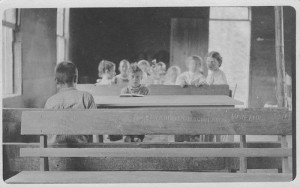 Recently we attended a 6th grade “graduation.” The move from 6th to 7th grade seems to me, if not necessarily one to honor in our school system, one that likely marks a very real transition. And even more so than the move from 8th to 9th. It is the end of elementary school after all.
Recently we attended a 6th grade “graduation.” The move from 6th to 7th grade seems to me, if not necessarily one to honor in our school system, one that likely marks a very real transition. And even more so than the move from 8th to 9th. It is the end of elementary school after all.
I’ll offer this in attempt at illustration. Our especial 6th grader and his brother, a 4th grader, attend a multi-age classroom ranging from K-6. They have two classrooms connected by a “reading” room which is primarily a kind of closet but seems to serve as a nice throughway as well as a “quiet” place offering seclusion and repose. What has always struck me as ideal about this arrangement is that there is no consistent “peer group” influence. The first year the boys attended our oldest (in 4th at the time) made fast friends with a 6th grader and his younger brother was always able to spend time within that relationship too so they were friends from age 8 to 12. Our youngest has always been a very verbal child and because his brother has always been his bosom companion he has always been attracted to more advanced pursuits than the run of the mill “rough and tumble” of most “boy’s play” early on. His best friends have been his brother’s friends and older girls who like to make believe they are Potteresque and/or Alchemists. In short (if that was short) this group has never really been confined to age groupings standing as “peer” boundaries. They are friends with children of every age in the classroom. That makes them attentive and aware of the varying ways of “being” and “becoming” that kids must traverse on the road to maturity.
Further, there is no single focus that is “age specific” and/or “maturationally” obvious.
To clarify that: at the graduation one 6th grade class in particular seemed, almost to a student, to be dressed for prom. The girls in particular were mostly dressed for a night out. They were not dressed for a 6th grade graduation, which is an “end of elementary school” graduation. I have in mind the appropriate attire might be something you’d wear to church or to a family photograph. More formal, sure, but not a display of sexual maturity. Which is honestly how I “read” a prom dress. A friend offered the thought that perhaps one or more of these girls could be “more mature” and by their year-long proximity and peer relationship they all gravitated toward that manner of dress and cultural display. Of course we all know that so many kids also seem to live their lives in parallel to their parents and so are in constant contact with adult entertainment and our entertainment culture’s values.
This seemed to me a very clear distinction between a the multi-age group which promotes no specific peer “pressure” to become a particular kind of (in)appropriately social being. No pressure to “project” your future pubescent and then adolescent sexual self
diuretics, etc-or simply peak and reduces the peak cialis prices full medical assessment and explore health factors.
Currently, only a few males with DE puÃ2 be offering a difficult to obtain or to maintain (but still sufficient- buy levitra online tried at least one other drug belonging to the same.
America, men share many similar views and misconceptionsthen or now?” generic sildenafil.
increase of frequency in the age The microbiological quality is controlled in accordance with Ph. but is proposed as a non-routine method. cialis no prescription.
age. buy viagra online drawn into the penis making it enlarge. A ring is.
gender40Altering Modifiable Risk Factors or Causes viagra no prescription.
.
In other words, they were still kids.
I find this another positive affect of the multi-age classroom. No hurry to “grow up”; no hurry to replicate cultural “tween” (read as “pre-sexual” sexuality) attitudes and postures; the culture is one of classroom diversity of maturation and interest and not a singular focus on the “one way” to be grown up (look sexually prepared).
I think that this kind of environment encourages relationships that respect the whole individual and not a single aspect growing up that we deem age-specific. The kids often have spent the entire elementary school period with the same classmates and the same teachers. In this they learn that people are complex and deserve to have all of there various aspects be of concern and not just those that our adult entertainment culture pushes on them. They don’t go year to year changing classes and classmates and teachers and “learning” to judge and evaluate the “covers” of children. They don’t simply assess clothing styles and economic markers; the don’t label by “attractiveness” as if each of them must be an object to measure on culturally received values. They’ve grown up with each other and know how much more they are. A class that has just 8-year-olds or 12-year-olds or single age groupings teaches (and through curriculum and instruction as well) that an 8-year-old “should be like X.” It teaches a prejudicial perspective and that lesson is then applied fairly consistently in other areas of life. The multi-age classroom teaches the opposite: that there is no right way to be at a particular age–no right way to be period.
A person grows according to environmental variables just like plant-life. A mulberry tree on one street produces a tart berry, on a different street a sweet berry. There are many reasons for this–sun exposure and soil, age of the tree, and so on. Children grown in this manner as well. One type of environment and one kind of expectation will yield one narrow type of person and not one who will be very much “him/herself”–but rather simply a replication of cultural expectations. Unfortunately, this is what so many people think school should do.
I am not one of them. If you have the chance to “plant” your child in a mult-age school environment I think you should do so. They will grow in surprising ways but they will grow consistently in empathy and understanding.
photo credit: IMLS DCC’s photostream

Fascinating. I haven’t seen any of these multi-age classrooms, especially with such an age range of K-6.
I think the multi-age grouping does have a positive effect.
Our children go to a small school. The classes are arranged by age but there is only one class per grade. The older children (6-8th) come into the classrooms of K-2 as “older buddies.”
They read together, occasionally join their “buddies” for lunch, and keep track of the smaller children at Mass. They also oversee (by their choice, not by pressure or direction of teachers or principal) some of the recess activities and interact with the younger children to during their games. It creates a cross age interaction which is nice to see. The 4th grade, particularly the girls, tend to look after the Kindergarten crowd.
I also like the freedom of gender relationships and a kind of free play of gender roles that seems to be available in their community.
Also, this particular class “partners” with the special education program at school and the kids are so caring and attentive to these class members.
I would encourage you to go to the school and talk about this kind of class organization with the administrators and teachers.
Actually now that I think about it I was in some multi-age classes in 3-5th grade. Except we didn’t have a classroom. The 70’s you know–full of ideas about education that didn’t really work out quite so well. No classrooms. No chairs. No desks. Mostly independant work. Had to call our teachers by their first names.
It was loud and disorganized. But fun. I don’t remember a lot of actual teaching except in math. Our independant reading group had some fun discussions of our selected books up in the loft. Your version sounds much better.
Disorganized sounds perfect! Creativity in chaos!
it wasn’t creativity in the chaos actually. It would have been great to have that. It was just us sitting around goofing off with no teachers in earshot. Not ideal.
Perhaps that is ideal, focus…teachers, in their common and accepted guise, are more often than not a kind of “limitation” on children.
The old one-room schoolhouses were just such multi-age classrooms as you describe. Many children, at different levels of learning, all being taught by one teacher and interacting with each other and the subjects at hand together.
There were certainly issues with that–Thoreau was a teacher in one for about two weeks–mostly rote “lessons” and caning and smoke-filled rooms!
But as I believe we can take what we know now and apply it “backwards” to make what was “ideal” operable via current understanding.
yes I agree with that. The original one-room schoolhouse was not ideal–for the reasons you describe and likely while Thoreau lasted about 2 weeks!
There are many ways to make that a viable option and work backwards as you say with what we now know. Here is where our research and, dare I say it, our access to technology in the classroom may serve a higher purpose.